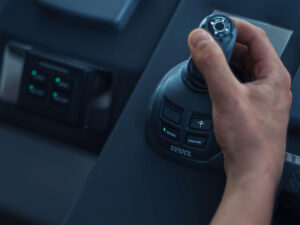I used to work with a former tugboat captain who taught me many things, including how to properly cleat a line. Walking the docks at the marina where we worked, he’d spot incorrectly cleated lines and retie them properly. Naturally, under most conditions, the different ways of cleating off—such as simply doing lots of figure eights, or not starting with a turn around the base of the cleat, or even simply wrapping line around and around—will hold in many situations. Still, because we have to cleat off some way anyway, we might as well be in the habit of doing it the best way we can. Here is that method, along with the reasons for each element.

1. Take a Turn Around the Base
Start by taking a turn around the base of the cleat with the line. This ensures that the load is spread evenly on all fasteners holding the cleat to the dock or boat. With respect to direction of pull on the line, take the line around the far horn first and then back under the closest horn. Now proceed to Step 2.
– INVEST IN SUCCESS –
Safety Tip Provided by the U.S. Coast Guard
A boating course is a great way to gain confidence and boat-handling skills. A little practice now will make it look easy when everyone is watching.

2. Figure Eight
After taking the line round under both horns, cross the line from under the nearest horn diagonally over the top of the cleat and then under the horn farthest away. Next, bring the line from under the farthest horn back diagonally across the top of the cleat. When looked at from above, you have formed a figure eight. This ensures that you are spreading the load evenly across both horns of the cleat. Proceed to Step 3.
– SHOW THEM HOW MUCH YOU CARE –
Safety Tip Provided by the U.S. Coast Guard
Nothing says ‘I love you’ like making sure the kids’ life jackets are snugged up and properly buckled.
Tip: Making multiple figure eights across the cleat doesn’t make the tie more secure. What it does do is take up all the space on the cleat, preventing you or others from using the cleat for another line, a fender, a bait cart or other item. A single figure eight is sufficient.

3. Half Hitch
Make the half hitch by bending the bitter end of the line under itself to form a loop. Place the loop over the horn. Pull the tag end to snug it all up. The half hitch locks the cleat hitch in place and prevents the line from slipping. Remember that in strong wind or rough waves, the line will be stretching—changing diameter—and the boat or dock structure might be flexing and vibrating. These can all cause line that is seemingly secure to slip. So, please: Add the half hitch.
Read Next: Three Choices for Nonsnag Cleats
– TOW LIKE A PRO –
Safety Tip Provided by the U.S. Coast Guard
When trailering, leave extra stopping room on the road. Be considerate of others on the ramp, but take the time you need to launch and recover your boat safely. Always check tie-downs, safety chains, lights – and the drain plug.

4. Be Neat
Be neat with any excess line. You don’t have to flemish it into coil, but do take care to arrange it neatly and in a way that others on the dock won’t trip over. If the cleat is vertical on a pole or pile, you can hang loops of excess line on the cleat.









